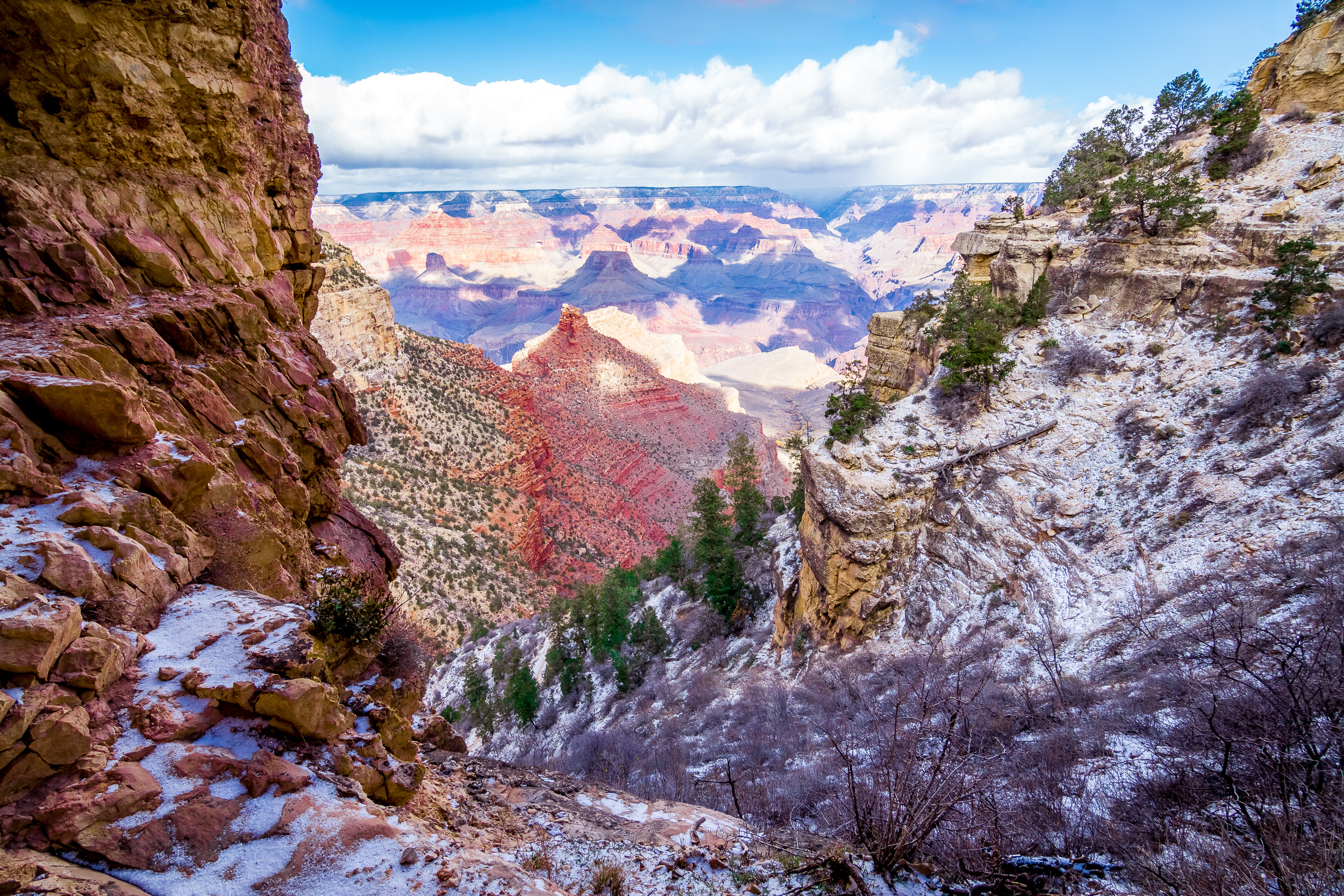



























This picture was taken in Arizona in lower Antelope Canyon. This particular formation is known by the Navajo People as the "Lady in the Wind".

Scholars beleive this broken land was formed by shifting sand dunes, between 66 and 200 million years ago. It is known as the Valley of Fire.

Found in the Valley of Fire, in Nevada, the White Domes are sandstone formations with contrasting colors and pink sand. This area was the location for the 1966 western film, The Professionals. The film was responsible for the development of the road which now provides access to this incredible site.

Historians date the petroglyphs of Atlatl Rock to be older than 1500 years in age. It was beleived to have been a shamanistic vision quest site.

This area of Zion National Park is known as the Big Bend. The three shaded mountains (from left to right), are known as Cable Mountain, The Great Organ, and The Great White Throne. The girl in the distance with the orange back pack is known simply as "Jenna".

As dusk fell we were treated to an amazing display of colors. I captured this shot just north of Rainbow Vista, deep in Nevada's Valley of Fire.

Black and white stripes, known as "patina" cascade along red sandstone at the Upper Emerald Pool in Zion National Park.

The Valley of Fire, in Nevada, was named for it's dark red sandstone formations that often appear to be on fire when reflecting the sun's rays. They were formed from great shifting sand dunes during the age of dinosaurs.

This is the beginning of the Zion - Mount Carmel Highway, a scenic road that bends up, and eventually through, the canyon mountain.

Due to its strange formations and unearthly colours, the Valley of Fire has been used by Hollywood to represent alien planets. Some examples include Schwarzenegger's Total Recall, and Star Trek: Generations.

This natural rock formation is known as Elephant Rock and it can be found in Nevada's oldest and largest state park, The Valley of Fire. It is a red sandstone outcrop that, from every perspective, looks very much like an elephant.

Here's another angle of Elephant Rock. From this low perspective the natural rock formation even appears to have eyes and a mouth, in addition to it's characteristic trunk.

Under the dramatic light of the setting sun, the red rocks of the ancient Aztec Sandstone reveal their characteristic colors and erosive, craggy shapes.

Another photo from the Lower Antelope Canyon in Arizona. This canyon is known as Hasdestwazi, or "spiral rock arches" to the Navajo Nation, and is regarded as a cathedral to the Elders. For millions of years, flash floods and strong winds have eroded the passageways, making the corridors deeper and smoothing the hard edges of the Navajo Sandstone, forming the characteristic flowing shapes in the rock.

These tan limestone mountains are from the Jurassic period, a remnant of the sand left behind by the wind after the land rose out of the sea.

I saw this beautiful tree at the entrance to the Temple of Sinawava, within Zion National Park.

A quick stop in the shade provided a much-needed break in one of the hottest places on earth.

Taken at Zion National Park in southern Utah, this path leads to Angel's Landing Trail, a 2.4 mile hike that takes you to the top of the canyon, formerly known as "The Temple of Aeolus".

I took this picture at the Calico Tanks at Red Rock Canyon, Nevada. The formation of the stone walls resembles Edvard Munch's "The Scream", so I'm unofficially naming this area "The Wailing Caverns". I hope the name sticks!

This is the third and final picture from the Lower Antelope Canyon, in Arizona. A long time ago, herds of pronghorn antelope roamed freely in Antelope Canyon, which explains the canyon's English name.

I found this natural rock formation in Sand Stone Quarry, within Red Rock Canyon in Nevada. This particular formation remains to be named, so it shall henceforth be known as Goblin Rock, for it's resemblance to a Goblin from World of Warcraft. Am I right?

This photo was taken at Red Rock Canyon, Nevada, at the Calico Tanks. The red color seen within the Aztec Sandstone is due to the presence of iron oxide and the mineral hematite. Exposure to the elements caused the iron minerals to oxidize or "rust", resulting in red, orange, and brown-colored rocks.

The ponderosa pine forest at the mouth of the canyon is a remnant from the last Ice Age. It survives here, at Red Rock Canyon in Nevada, thanks to the cool air and water that flows down Pine Creek Canyon. It was one of our favorite hikes; so much so that at the end of our road trip, we journeyed back to hike it again.

Jenna and I ventured across Arizona to reach the Grand Canyon on Christmas Day. There was a snowfall in the early morning which powdered parts of the canyon, a unique treat after the harsh, but beautiful, desert landscapes that made up most of our road trip.

Here's another photo from the South Rim of the Grand Canyon. The view is so overwhelming that even as I stood looking across, I couldn't fully grasp how big it truly was. So here are some stats: the canyon river is 446 km long, 29 km wide, and 1.6 km deep!